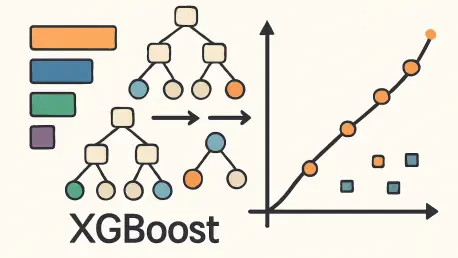Imagine a machine learning competition where the stakes are high, and the dataset is riddled with complex patterns that defy traditional models, making it a daunting challenge for data scientists. In such a scenario, boosting algorithms emerge as a powerful ally, transforming a collection of weak predictive models into a robust, high-performing ensemble capable of tackling intricate challenges. Boosting, as an ensemble learning technique, focuses on iteratively improving predictions by emphasizing errors from previous iterations, making it especially potent for structured or tabular data commonly found in business and research applications.
The significance of boosting in machine learning cannot be overstated, as it provides a framework to achieve remarkable accuracy where single models often fall short. Among the myriad of boosting implementations, XGBoost, or Extreme Gradient Boosting, stands out as a transformative force. Its exceptional performance has made it a staple in diverse fields, from dominating competitive platforms like Kaggle to powering critical real-world systems in finance and healthcare, due to its ability to handle complex datasets with unparalleled efficiency.
This guide delves into the essence of boosting, explores why XGBoost has become a game-changer, and examines its innovative features that set it apart from traditional methods. Key areas of focus include the fundamental principles behind boosting, the unique advancements introduced by XGBoost, practical applications that demonstrate its prowess, and the broader impact it has on the machine learning landscape, offering a comprehensive look at how this tool redefines predictive modeling.
Why XGBoost Stands Out Among Boosting Algorithms
In the realm of machine learning, solving intricate problems often demands advanced techniques that can navigate the nuances of diverse datasets with precision and efficiency. Boosting algorithms have long been recognized for their ability to address such complexities by iteratively refining predictions. However, XGBoost elevates this approach to new heights, offering a solution that combines precision with practicality, making it indispensable for practitioners aiming to push the boundaries of model performance.
The adoption of XGBoost is driven by its ability to deliver high accuracy and robustness, crucial for applications where predictive reliability is paramount. Unlike traditional boosting methods, it incorporates enhanced computational efficiency, built-in mechanisms to prevent overfitting through regularization, and adaptability to a wide array of data challenges, such as missing values or imbalanced classes. These attributes ensure that models remain both powerful and generalizable across different contexts.
Beyond technical superiority, XGBoost offers scalability to handle large datasets, interpretability through feature importance tools, and seamless integration into production environments. Such versatility makes it a preferred choice for data scientists and organizations seeking to deploy reliable solutions in real-time systems, distinguishing it as a leader among boosting frameworks and a benchmark for modern machine learning tasks.
Key Innovations of XGBoost in Boosting Techniques
XGBoost introduces a suite of groundbreaking features that redefine the capabilities of boosting algorithms, addressing longstanding limitations in model training and deployment. These advancements not only enhance predictive power but also improve usability, making it accessible for a wide range of applications. Each innovation tackles specific challenges, ensuring that the framework remains at the forefront of machine learning technology.
From regularization techniques to efficient computation, XGBoost’s contributions are both theoretical and practical, directly impacting how models perform under real-world conditions. Understanding these features provides insight into why this tool consistently outperforms its predecessors. The following sections break down these key innovations, illustrating their significance through detailed explanations and relevant examples.
The practical relevance of these advancements is evident in diverse domains, where data complexities often hinder traditional approaches. By integrating cutting-edge solutions, XGBoost ensures that practitioners can achieve superior results, whether working on small-scale experiments or large industrial projects, highlighting its role as a transformative force in the field.
Advanced Regularization to Combat Overfitting
One of the most significant hurdles in boosting algorithms is overfitting, where models become too tailored to training data and fail to generalize to new instances. XGBoost addresses this through advanced regularization techniques, incorporating L1 and L2 penalties to control model complexity. This approach adds constraints to the learning process, preventing excessive reliance on specific features or patterns.
The regularization parameters, known as reg_alpha and reg_lambda, play a pivotal role in striking a balance between bias and variance. By fine-tuning these settings, practitioners can mitigate the risk of overfitting while maintaining the model’s ability to capture essential trends, ensuring better performance on unseen data. This mechanism is a cornerstone of XGBoost’s ability to deliver robust predictions.
Case Study: Regularization in Action
Consider a dataset with high-dimensional features, where the risk of overfitting is particularly pronounced due to the sheer number of variables. By applying XGBoost’s regularization, the model can prioritize meaningful predictors while dampening the influence of noise, resulting in improved generalization. In such a scenario, test performance metrics show a marked reduction in error rates, underscoring the practical value of this feature in real-world settings.
Efficient Computation with Parallelization and Tree Pruning
Training boosting models on large datasets can be computationally intensive, often requiring significant time and resources. XGBoost overcomes this barrier through parallel computation, distributing tasks across multiple cores to accelerate the training process. This efficiency is critical for handling big data scenarios without compromising on speed or quality.
Additionally, innovative tree pruning techniques optimize resource usage by eliminating unnecessary branches during model construction. Unlike traditional methods that build trees to full depth before pruning, XGBoost employs a proactive strategy, stopping growth when further splits offer no benefit. This dual approach of parallelization and pruning makes the framework exceptionally scalable, setting a new standard for performance.
Real-World Example: Speeding Up Training
In a financial forecasting application involving millions of transactions, the ability to train models swiftly is paramount. XGBoost’s parallel processing and tree pruning capabilities drastically reduce training time, allowing analysts to iterate rapidly and refine predictions. Such efficiency translates into tangible time savings, enabling faster decision-making in high-stakes environments.
Handling Missing Data and Sparsity-Aware Algorithms
Real-world datasets frequently contain missing values or sparse structures, posing challenges for many machine learning algorithms. XGBoost stands out with its built-in ability to handle missing data automatically, assigning them to optimal splits during tree construction without requiring manual imputation. This feature simplifies preprocessing and ensures model integrity.
Moreover, sparsity-aware split-finding algorithms enhance efficiency by focusing computational effort on non-zero elements in the data. This is particularly beneficial for datasets with a high proportion of missing or zero values, as it minimizes wasted resources. Together, these capabilities make XGBoost a robust choice for diverse, imperfect datasets encountered in practice.
Application in Healthcare Data
An example from the UCI Breast Cancer dataset highlights XGBoost’s prowess in managing missing values during a binary classification task. By seamlessly integrating these gaps into the learning process, the model maintains strong predictive performance, accurately distinguishing between outcomes. This reliability is invaluable in sensitive domains like healthcare, where data quality often varies.
Enhanced Model Tuning and Interpretability Tools
Achieving optimal performance with boosting models requires meticulous tuning of hyperparameters, and XGBoost excels in this area with comprehensive support for customization. Parameters such as learning rate, maximum tree depth, and the number of estimators can be adjusted using techniques like grid search and early stopping, ensuring the model avoids overtraining while maximizing accuracy.
Equally important is the framework’s emphasis on interpretability, offering built-in tools to visualize feature importance. These insights reveal which variables drive predictions, fostering transparency and trust in the model’s decisions. Such capabilities are essential for stakeholders in regulated industries who need to justify outcomes based on clear evidence.
Impact of Tuning on Model Accuracy
Using the same Breast Cancer dataset as a benchmark, tuning XGBoost’s parameters can elevate baseline accuracy from over 95% to even higher levels. Adjusting settings through systematic optimization reveals the full potential of the model, demonstrating how strategic configuration enhances results. This iterative process underscores the importance of tailoring the framework to specific tasks for superior outcomes.
The Future of Boosting with XGBoost: Practical Takeaways and Recommendations
XGBoost remains a gold standard for structured data problems, revolutionizing boosting algorithms with its unmatched predictive power and flexibility. Its advantages over alternatives like random forests, logistic regression, and support vector machines are evident in its capacity to discern complex patterns and excel with difficult-to-predict instances, cementing its status as a leading choice for intricate machine learning challenges.
For practitioners and organizations, adopting XGBoost involves understanding key hyperparameters, leveraging interpretability tools to gain actionable insights, and addressing data imbalances through mechanisms like scale_pos_weight. Careful attention to computational resource needs and domain expertise in interpreting outputs is also essential to ensure successful deployment across varied applications.
Specific recommendations include starting with default settings before fine-tuning for specific datasets, using cross-validation to validate performance, and exploring feature importance visualizations to inform decision-making. By prioritizing these practices, data scientists can harness XGBoost’s full potential, paving the way for innovative solutions and sustained impact in the evolving landscape of machine learning.









